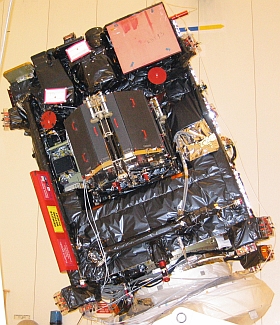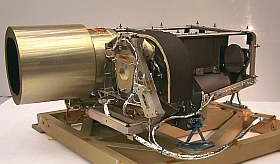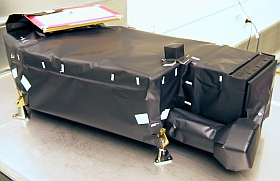
|
OSIRIS
|
 |

|
OSIRIS
|
 |
 OSIRIS (Optical, Spectroscopic, and Infrared Remote Imaging System) is the main scientific imaging system on the orbiter of ESA's
OSIRIS (Optical, Spectroscopic, and Infrared Remote Imaging System) is the main scientific imaging system on the orbiter of ESA's ![]() Rosetta mission to comet 67P/Churyumov-Gerasimenko.
Rosetta mission to comet 67P/Churyumov-Gerasimenko.
OSIRIS comprises a high resolution Narrow Angle Camera (NAC) and a Wide Angle Camera (WAC). The NAC is designed to obtain high resolution images of the surface of comet 67P/Churyumov-Gerasimenko through 12 discrete filters over the wavelength range from 250 to 1000 nm at an angular resolution of 18.6 µrad/px. The WAC is optimised to provide images of the near nucleus environment in 14 discrete filters (240-720 nm) at an angular resolution of 101 µrad/px. Both cameras are equipped with 2048 x 2048 pixel CCD detectors, and have an off-axis optical configuration.
After the launch of Rosetta (2nd March 2004), OSIRIS was commissioned in seven slots between March 2004 and June 2005, and has been activated on several occasions before Rosetta arrives in 2014 at its main target, comet 67P/Churyumov-Gerasimenko. OSIRIS already performed several important scientific observations:
- A monitoring campaign of comet 9P/Tempel 1 around the Deep Impact event on 4 July 2005 [more]
- A swing-by manoevre at Mars on 26 February 2007 [more]
- The fly-by of asteroid 2867 Steins on 5 September 2008 [more]
- Two Earth swing-bys in Nov. 2007 and Nov. 2009
- The observation of the remnant of a collision between two main-belt asteroids in February 2010 [more]
- The fly-by of asteroid 21 Lutetia on 10 July 2010 [more]
- Early observation of the comet from more than 1AU distance in March 2011.
The OSIRIS cameras were provided by a consortium of 9 institutes from 5 European countries and from ESA, under the leadership of the the Max-Planck-Institute for Solar System Research (MPS) (Principal Investigator: Holger Sierks). The participating institutes of the consortium are:
MPS (Katlenburg-Lindau, Germany), LAM (Marseille, France), UPD (Padova, Italy), IAA (Granada, Spain), University of Uppsala (Sweden), ESTEC (ESA, Noordwijk, The Netherlands), UPM (Madrid, Spain), INTA (Madrid, Spain), IDA (Braunschweig, Germany) [more]
| Science Objectives |
|
| The Instrument |
|
| The Team |
|
| Related Press Releases |
|
| Related Links |
|
| Member Institutes of the OSIRIS consortium |
|
| TEAM ACCESS to Document Server |
|
| OSIRIS publications by MPS members |
The main objetive of OSIRIS is to study the physical and chemical processes that occur in, on, and near the cometary nucleus. In particular, OSIRIS allows researchers to determine the outflow of gas and dust from different regions of the cometary nucleus, and to compare active areas with deviations in surface mineralogy, in topography, and in local insolation. The main science objetives of OSIRIS are:
The OSIRIS cameras are unobstructed mirror systems, equipped with two filter wheels containing 8 position each, and with backside illuminated CCD detectors comprising 2048 x 2048 pixels with a pixel size of 13.5 µm. Both cameras use identical image acquisition systems, consisting of the Focal Plane Assembly and the CCD Readout Box. The following two figures show the two OSIRIS cameras (NAC and WAC).
OSIRIS comprises two cameras:
 NAC (Narrow Angle Camera)
NAC (Narrow Angle Camera) WAC (Wide Angle Camera)
WAC (Wide Angle Camera)
| Holger Sierks | OSIRIS Principal Investigator | +49 5556 979 242 | |
| Jessica Agarwal | Associate Scientist | ||
| Colin Snodgrass | Associate Scientist | ||
| Cecilia Tubiana | Associate Scientist | ||
| Jean-Baptiste Vincent | Associate Scientist | ||
| Nilda Oklay | Associate Scientist | ||
| Pablo Gutierrez-Marques | Instrument Operation Manager | ||
| Irene Büttner | Ground Segment Engineering | ||
| Ian Hall | Programmer | ||
| Marc Hofmann | Ph.D. Student | ||
| Sebastian Höfner | Ph.D. Student | ||
| Jacob Deller | Ph.D. Student | ||
| Michael Richards | Quality Assurance | ||
| Daniel Maase | Computer Maintenance | ||
| Fee von Saltzwedel | Secretary | ||
|
Primal rock in space Press Release 23/2011 - October 28, 2011
Lutetia is a real fossil: several areas of the asteroid's surface are around 3.6 billion years old and thus some of the oldest in the planetary system. Its high density means Lutetia is also a planetesimal, the first stage of development on the way to becoming a planet. These findings have been obtained by scientists headed by the ... [more] |
|
Rosetta's first glimpse of the comet Press Release 13/2011 - June 8, 2011
Approximately 163 million kilometers still separate ESA's spacecraft Rosetta from comet Churyumov-Gerasimenko, its 2014 target. Despite this remarkable distance, scientists from the Max Planck Institute for Solar System Research (MPS) in Germany have succeeded in obtaining the first images of the remote destination using the onboard camera system OSIRIS. These ... [more] |
|
Rosetta's unique view of an asteroid collision Press Release 13/2010 - October 13, 2010
In the first half of February 2009 two asteroids collided in a region of space beyond the orbit of Mars, as scientists from the Max Planck Institute for Solar System Research (MPS) in Germany have now discovered. The researchers were able to pinpoint the exact date of the impact ... [more] |
|
Erste Bilder des Asteroiden Lutetia Press Release 09/2010 - July 10, 2010
Die ESA-Raumsonde Rosetta ist am Samstag, 10. Juli, gegen 18 Uhr an dem Asteroiden Lutetia vorbeigeflogen. Bilder dieses einzigartigen Ereignisses hat das Kamerasystem OSIRIS aufgenommen, das unter Leitung des Max-Planck-Instituts für Sonnensystemforschung (MPS) im niedersächsischen ... [more] |
|
Rendezvous mit einem Riesenbrocken Press Release 08/2010 - July 6, 2010
Auf eine besondere Begegnung steuert die ESA-Raumsonde Rosetta am Samstag, 10. Juli, gegen 18 Uhr zu. Nur etwa 3000 Kilometer werden die Raumsonde dann von dem Asteroiden Lutetia trennen. Mit einem Durchmesser von etwa 100 Kilometern ist Lutetia bei Weitem der ... [more] |
|
Diamant im All Press Release 01/2010 - January 7, 2010
Im Fernrohr ist der Kleinplanet Steins ein unscheinbares Lichtpünktchen. Bei näherem Hinsehen entpuppt er sich als eine Art Schutthalde mit diamantähnlicher Form und großen Kratern auf der Oberfläche. Näher hingesehen hat ein Team um Horst Uwe Keller vom Max-Planck ... [more] |
|
Die "Augen" der Raumsonde ROSETTA fotografieren die Erde aus dem All Press Release 11/2009 - November 17, 2009
Die ESA-Raumsonde Rosetta flog am 12. November 2009 mit einer Geschwindigkeit von 50.000 km/h an der Erde vorbei. Diesen Vorbeiflug nutzten die Wissenschaftler aus dem Max-Planck-Institut für ... [more] |
|
Erste Bilder des Asteroiden Steins Press Release 14/2008 - 8th September 2008
Die ESA-Raumsonde Rosetta ist in der vergangenen Nacht in nur 800 Kilometern Entfernung an dem Asteroiden Steins vorbeigeflogen. Mit Hilfe des Kamerasystems OSIRIS, das unter Leitung des Max-Planck-Instituts für Sonnensystemforschung (MPS) entwickelt wurde, sind spektakuläre ... [more] |
|
Eine Kamera navigiert durchs All Press Release 12/2008 - 28th August 2008
Die ESA-Raumsonde Rosetta fliegt am Freitag, 5. September, an einer besonderen "Sehenswürdigkeit" vorbei: Nur etwa 800 Kilometer werden die Sonde vom Asteroiden Steins trennen. Die Begegnung bietet Forschern erstmals die Gelegenheit, einen Asteroiden dieses Typs aus ... [more] |
|
First OSIRIS images from Rosetta Earth swing-by Press Release 15/2007 - 15th November 2007
|
Related links
Member institute homepages
| ||||||||||||||||||||||||||||||||||||||||||||||||||||||||||||||